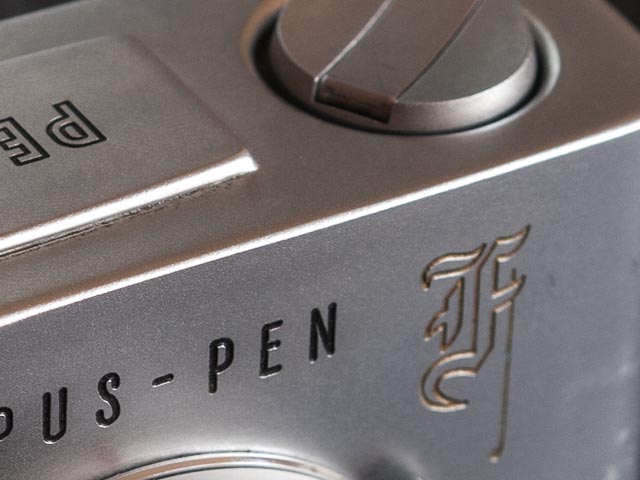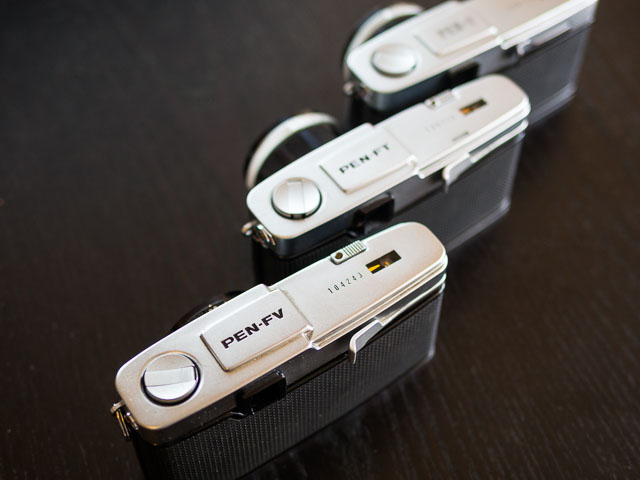Olympus Pen F series
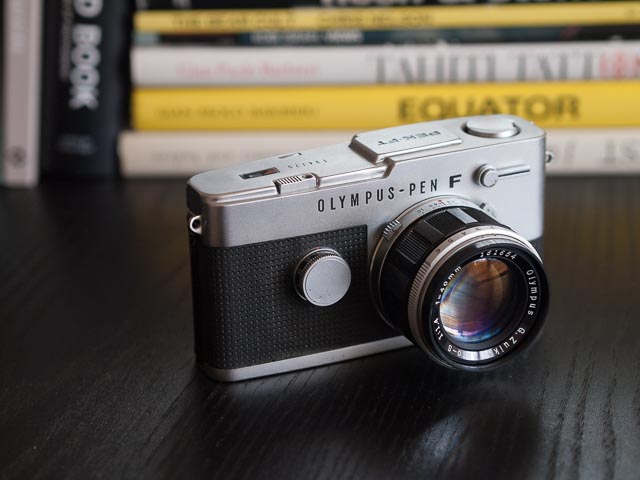
Read more on the Olympus Pen F series:
When the original Olympus Pen F 35mm half-frame SLR was introduced in 1963 it was the smallest full system SLR in the world. It is also the only 35mm SLR system ever designed from the ground up for half-frame. It is a uniquely styled camera with a smooth, sleek, minimalist design made possible by the use of a system of mirrors instead of a conventional pentaprism, hence no characteristic SLR bump on top. This system of mirrors included an unusual primary mirror that moved vertically out of the light path when the shutter was released.
In my opinion the Pen F series is one of the most beautiful cameras ever designed. It is a very high quality device with very smooth operation.
The Olympus Pen FT replaced the Pen F in 1966. It introduced a number of minor improvements (i.e. a single stroke film advance instead of double stroke, a self timer and a focusing screen with a micro prism) and one major advance in the form of open-aperture TTL (through the lens) exposure metering. This was at a time such things were still something of a novelty. The metering system utilised a semi-silvered mirror that directed some light to the metering cell, and the rest to the viewfinder. This resulted in a viewfinder that was unfortunately a little dimmer than the original Pen F.

The viewfinder of the Pen FT has a series of numbers from 0 to 7 in the viewfinder with a needle to indicate a number. This number must then be set on the lens. There is no coupling to either the lens or the shutter speed: you must take your eye away from the viewfinder to transfer the number observed in the viewfinder to the lens. Overall the system is rather cumbersome, but at the time I think TTL metering was enough of a surprising novelty for people to forgive this!
Lenses made after the introduction of the Pen FT have an aperture ring with light meter numbers on one side and F numbers on the other. The aperture ring can be turned all the way around so either the light meter numbers or F stops are on top of the lens. This system was claimed to be easier to understand then obscure F stop numbers, which tend to confuse beginners. But to be honest it is a rather slow and cumbersome in practice!
The Pen FV was introduced shortly after the Pen FT. It included all the improvements of the Pen FT, but without the TTL metering and it therefore had the brighter viewfinder of the original Pen F. The Pen FV is considerably rarer than the Pen F or Pen FT and often commands higher prices, though the rare black version of the Pen FT is the most sought after, and most valuable, model of all.
Apart from being the first half-frame SLR (yielding 72 exposures on a 36 exposure film), the Pen F series had a number of other innovations, including an unusual rotating focal plane shutter that permitted flash synchronisation at all shutter speeds. This is a feature that remains unique among focal plane shutter cameras to this day.
The Pen F camera was part of a comprehensive system. There was a range of lenses from 20mm to 800mm, including ultra fast lenses with apertures as fast as f/1.2, macro lenses, mirror lenses and some early examples of zoom lenses. Note that there is an approximate conversion factor of 1.4x to give 35mm equivalents focal lengths. The only thing lacking in the Pen F lens range was an ultra wide-angle lens, the widest being a 20mm lens giving a field of view similar to a 28mm lens on a full frame 35mm camera. There were also accessories such as an external meter for the Pen F/FV, bellows units, extension tubes and reversing adapters for close focus (and, indeed, extreme close focus) photography, and flash units.
Olympus used some very clever marketing for the Pen F range which naturally focused on the very small size of the Pen F system. There was even an advert featuring a shoe being used as a camera bag!
| Picture size: | 24x18mm |
|---|---|
| Lens mount: | Olympus "Pen" Bayonet system |
| Shutter: | Olympus rotary metal focal-plane shutter; B. 1-1/500sec. (equally calibrated) one-pivot non rotating shutter speed dial |
| Synchronising: | All shutter speeds synchronisation with X contact |
| Viewfinder: | Porroprism finder, magnification 0.8x (standard lens), with Fresnel lens. |
| Mirror: | Horizontally revolving, quick return |
| Loading: | EL (easy loading) system |
| Film advancing: | Double action with 90 degree self-cocking lever. Double exposure impossible. |
| Film counter: | Exposed counting, self-resetting type |
| Film rewinding: | Crank type rewind button setting system |
| Focus adjustment: | Direct advancing helicoid system, minimum close-up distance 35cm |
| Rear cover operation: | Hinge system with release built into rewind knob. |
| Size & weight: | 127x69.5x62.5mm, 560grams (with f/1.8 standard lens) |
| Picture size: | 24x18mm |
|---|---|
| Lens mount: | Olympus "Pen" Bayonet system |
| Shutter: | Olympus rotary metal focal-plane shutter; B. 1-1/500sec. (equally calibrated) one-pivot non rotating shutter speed dial |
| Synchronising: | All shutter speeds synchronisation with M & X contacts point switch |
| Viewfinder: | Porroprism finder, magnification 0.8x (standard lens), with micro-prism and special Fresnel lens. |
| Mirror: | Horizontally opening shock-less quick return mirror |
| Loading: | EL (easy loading) system |
| Film advancing: | 1-stroke lever type wth an advancing angle of 150 degrees, self-cocking to prevent double advances and double exposures |
| Film counter: | Exposed counting, self-resetting type |
| Film rewinding: | Crank type rewind button setting system |
| Focus adjustment: | Direct advancing helicoid system, minimum close-up distance 35cm |
| Exposure adjustment: | Through-the-lens number system, both ope and stopped-down aperture methods available |
| Light measuring range: | EV3~EV17 (ASA100) with f/1.4 standard lens |
| Light acceptor: | Extra large CdS meter, average light measurement method |
| Power source: | Mercury battery (1.3 volts) |
| Film speed scale: | ASA25-400 |
| Self-timer: | Lever system (90 degrees) actuated in about 11 seconds |
| Rear cover operation: | "Magic" locking hinge system |
| Size & weight: | 127x69.5x62.5mm 600grams (with f/1.8 standard lens) |
| Focal length | 35mm equiv. | Aperture | Type | Minimum distance | Filter | Weight |
|---|---|---|---|---|---|---|
| 20mm | 28mm | F3.5 | G.Zuiko Auto-W | 20cm | 43mm | 145gr |
| 25mm | 35mm | F4.0 | E.Zuiko Auto-W | 25cm | 43mm | 120gr |
| 25mm | 35mm | F2.8 | G.Zuiko Auto-W | 25cm | 43mm | 160gr |
| 38mm | 55mm | F3.5 | E.Zuiko Auto-Macro | 15.6cm | 43mm | 175gr |
| 38mm | 55mm | F2.8 | D.Zuiko Auto-S | 80cm | 43mm | 125gr |
| 38mm | 55mm | F2.8 | E.Zuiko Auto-S | 80cm | 43mm | 70gr |
| 38mm | 55mm | F1.8 | F.Zuiko Auto-S | 35cm | 43mm | 135gr |
| 40mm | 58mm | F1.4 | G.Zuiko Auto-S | 35cm | 43mm | 165gr |
| 42mm | 60mm | F1.2 | H.Zuiko Auto-S | 35cm | 49mm | 255gr |
| 60mm | 85mm | F1.5 | G.Zuiko Auto-T | 80cm | 49mm | 270gr |
| 70mm | 100mm | F2.0 | F.Zuiko Auto-T | 80cm | 43mm | 230gr |
| 100mm | 143mm | F3.5 | E.Zuiko Auto-T | 1.5m | 43mm | 250gr |
| 150mm | 210mm | F4.0 | E.Zuiko Auto.T | 1.7m | 49mm | 380gr |
| 250mm | 360mm | F5.0 | E.Zuiko T | 3.5m | 58mm | 800gr |
| 400mm | 580mm | F6.3 | E.Zuiko T | 5m | 72mm | 1750gr |
| 800mm | 1150mm | F8.0 | Zuiko Mirror T | 15m | 25.5mm | 2000gr |
| 50-90mm | 70-130mm | F3.5 | Zuiko Auto-Zoom | 1.5m | 49mm | 420gr |
| 100-200mm | 143-286mm | F5.0 | Zuiko Zoom | 1.7m | 49mm | 700gr |
My Olympus Pen F system

Olympus Pen F
I bought this camera mainly for the lens it came with, the rather rare 38mm f/2.8 pancake. But it is also nice to have the original Pen F camera in my collection with it’s lovely gothic letter F on the front.

Olympus Pen FT
This camera, pictured here with the 40mm f/1.4 lens that it came with, has been in my collection for a long time. There have been times in the past when I have sold almost my entire collection, but this is one camera I have never been able to part with!

Olympus Pen FV
I suppose sooner or later I'd have to add the final Pen F camera, the Pen FV, to my collection! My Pen FV came with the original (i.e. non-pancake) version of the 38mm f/2.8 lens.
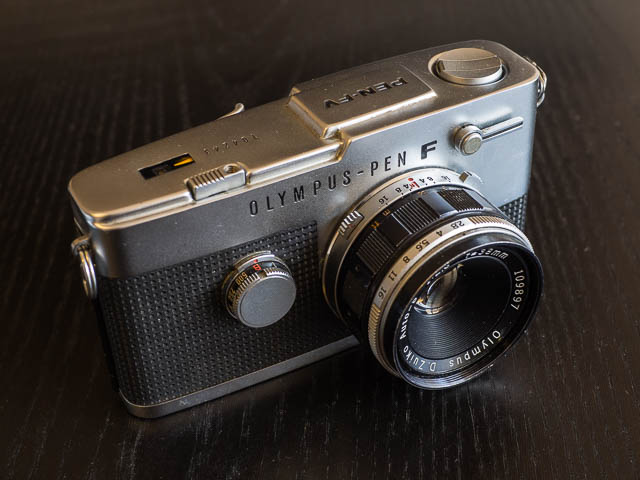
Olympus Pen F G.Zuiko Auto-W 20mm f/3.5
This is the widest angle lens in the Olympus Pen F range. When used on a Pen F film camera the field of view is similar to a 28mm lens on a full frame 35mm camera. When used on a digital camera with the an APS-C sensor the full frame equivalent field of view is 30mm, and it’s 40mm on a M4/3 camera.
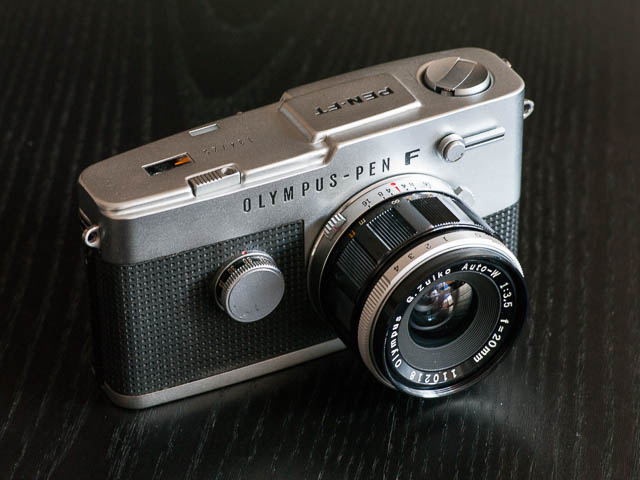





See how the Olympus Pen F G.Zuiko Auto-W 20mm f/3.5 performs on a full-frame camera.
Olympus Pen F E.Zuiko Auto-W 25mm f/4
Along with the 100mm f/3.5, this is the most common lens in the Pen F range. When used on a Pen F film camera the field of view is similar to a 35mm lens on a full frame 35mm camera. When used on a digital camera with an APS-C sensor the full frame equivalent field of view is 37.5mm, and it’s 50mm on a M4/3 camera.
The 25mm f/4 and 100mm f/3.5, along with one of the standard lenses would have been a very common outfit. Unfortunately my example of the 25mm f/4 has a dysfunctional aperture diaphragm, which is why I purchased the f/2.8 version (see below) to replace it. But that doesn’t necessarily stop me from mounting it on a digital camera, it just means I’m limited to using it permanently at it’s maximum aperture.






See how the Olympus Pen F E.Zuiko Auto-W 25mm f/4 performs on a full-frame camera.
Olympus Pen F G.Zuiko Auto-W 25mm f/2.8
The f/2.8 version of the 25mm was a much higher quality lens than the f/4 version. It is also a much larger and heavier lens. This is quite a rare lens. My example is in rather rough condition, and the focus ring has some play in it, but optics are in very good condition. When used on a digital camera this lens is certainly capable of very fine results.
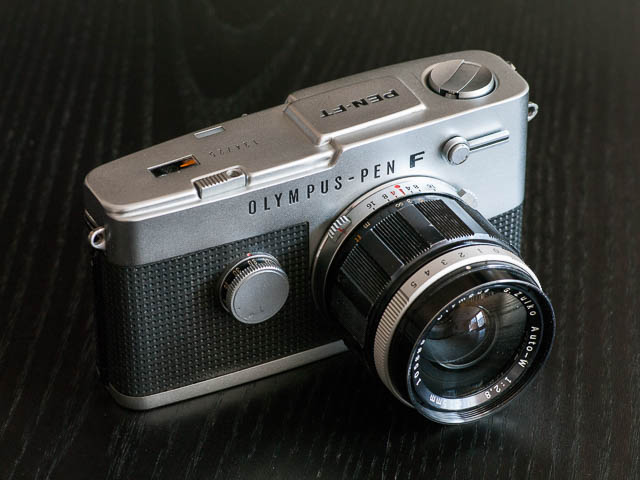





See how the Olympus Pen F G.Zuiko Auto-W 25mm f/2.8 performs on a full-frame camera.
Olympus Pen F D.Zuiko Auto-S 38mm f/2.8
This is one of the less known of the Olympus Pen F lenses. Most Pen F collectors have heard of the amazingly tiny 38mm f/2.8 pancake lens, but this is the original 38mm f/2.8 lens, a simple 4 element lens intended as a budget option for those who wanted to get in to the Pen F system at the lowest possible entry point. It was only produced quite early in the life of the Pen F series, so it's actually quite rare, but because it is one of the less technically interesting Pen F lenses it isn't in high demand, despite it's rarity. My copy came with my Pen FV.


See how the Olympus Pen F D.Zuiko Auto-S 38mm f/2.8 performs on a full-frame camera.
Olympus Pen F F.Zuiko Auto-S 38mm f/1.8
This lens is by far the most common lens in the Pen F system. It was launched alongside the first Olympus Pen F camera in 1963. It was effectively the 'kit' lens (to use a modern term!) for the Pen F system and most buyers would have got this lens with their camera. It is very compact, despite is relatively fast maximum aperture of f/1.8. Because this lens was made during the entire lifespan of the Pen F system is available in two versions both with and without the metering numbers designed to work with the later Pen FT's TTL metering system.
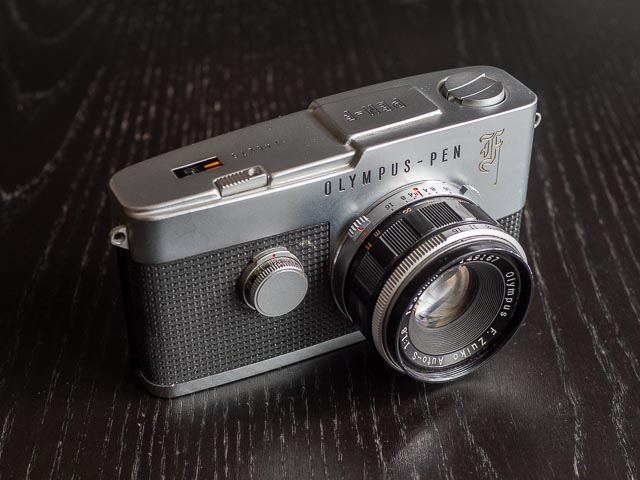

Bought in 2025, this is a very recent acquisition for me, and I havn't yet had the chance to put it to use. But my initial test shots, shot to test the extent of this lens's vignetting on a full-frame digital camera, were very promising, and you can see how the Olympus Pen F F.Zuiko Auto-S 38mm f/1.8 performs on a full-frame camera here. I certainly wish I had added this lens to my collection much earlier!
Olympus Pen F E.Zuiko Auto-S 38mm f/2.8 (pancake)
This is by far and away the smallest lens in the Pen F range. It turns the Pen F cameras into truly pocketable 35mm SLR cameras, and there aren’t many cameras that can claim that! As with most ‘pancake’ type lenses ergonomics take a back seat to small size… with no room for a proper focusing ring you have to feel for the two focusing tabs on each side of the lens.
When used on a Pen F film camera the field of view is similar to a 55mm lens on a full frame 35mm camera. When used on a digital camera with the an APS-C sensor the full frame equivalent field of view is 57mm, and it’s 76mm on a M4/3 camera. Using this lens on a digital camera is certainly fun, but it seems with this lens image quality also takes a back seat to small size! With extremely soft corners the result certainly have character, which I actually quite like, but this lens certainly isn’t one to choose when you’re looking for high resolution!






See how the Olympus Pen F E.Zuiko Auto-S 38mm f/2.8 (pancake) performs on a full-frame camera.
Olympus Pen F E.Zuiko Auto-Macro 38mm f/3.5
Olympus had quite an extensive range of close-up equipment in the Pen F system, including a bellows unit and this macro lens. Below left you can see this lens racked out to it’s closest focus setting.
It is a tiny and very convenient lens that was really quite ground breaking at the time it was launched. It is one of the rarer Pen F lenses. With it’s 38mm focal length this lens give a field of view similar to a 55mm lens on a full frame 35mm camera. When used on a Pen F film camera the field of view is similar to a 55mm lens on a full frame 35mm camera. When used on a digital camera with the an APS-C sensor the full frame equivalent field of view is 57mm, and it’s 76mm on a M4/3 camera.
Below is a test shot of a stamp using my Olympus E-PL3 camera. The sensor on this camera is 13mm wide, and a UK stamp is 15mm wide, so as you can see this lens is getting very close to a 1:1 reproduction ration!
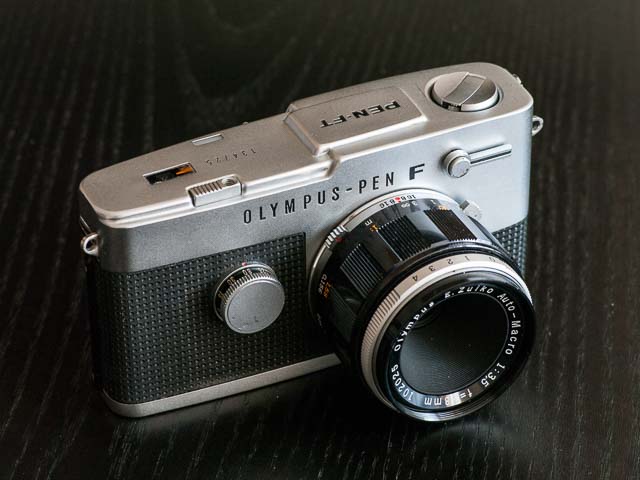







See how the Olympus Pen F E.Zuiko Auto-Macro 38mm f/3.5 performs on a full-frame camera.
Olympus Pen F G.Zuiko Auto-S 40mm f/1.4
This is one of a wide range of standard lenses Olympus made for the Pen F system, there where 5 in total: a 38mm f/2.8 pancake (see above), a 38mm f/2.8 normal model (only produced for a short time very early on in Pen F range), the 38mm f/1.8 (the most common, and, some would say, the sharpest), the 40mm f/1.4 you see here, and finally the rare and desirable (though apparently not very sharp!) 42mm f/1.2, which is the fastest lens in the whole Pen F range.
I really love this lens and I have taken many photographs with it on various digital cameras. When used on a Pen F film camera the field of view is similar to a 58mm lens on a full frame 35mm camera. When used on a digital camera with the an APS-C sensor the full frame equivalent field of view is 60mm, and it’s 80mm on a M4/3 camera. It gives a very distinctive quality to the out-of-focus areas of a shot (otherwise known as ‘bokeh’) that is quite unlike a modern lens.










See how the Olympus Pen F G.Zuiko Auto-S 40mm f/1.4 performs on a full-frame camera.
Olympus Pen F G.Zuiko Auto-T 60mm f/1.5
This is the fastest telephoto lens in the Pen F range. When used on a Pen F film camera the field of view is similar to a 85mm lens on a full frame 35mm camera. When used on a digital camera with the an APS-C sensor the full frame equivalent field of view is 90mm, and it’s 120mm on a M4/3 camera.
When I first tried this lens I wasn’t too sure about the bokeh, but that was with subjects in the middle distance (3-5 meters). with subjects in the close range (1-2 meters) I like the bokeh much better. Typical of most fast Pen F glass this is a real double personality lens: wide open you get a real vintage look with very distinctive bokeh, and stopped down you get a much more modern look.






See how the Olympus Pen F G.Zuiko Auto-T 60mm f/1.5 performs on a full-frame camera.
Olympus Pen F F.Zuiko Auto-T 70mm f/2.0
This lens is a fraction longer and 1 stop slower slower than the 60mm lens above, but when used as a set with the 20mm and 40mm lenses it's a more useful focal length, and still fast enough for some very satifying shallow depth-of-field effects. When used on a Pen F film camera the field of view is similar to a 100mm lens on a full frame 35mm camera. When used on a digital camera with the an APS-C sensor the full frame equivalent field of view is 105mm, and it’s 140mm on a M4/3 camera.
Rather unusually, I have the original box, case, hood and caps for this lens.






See how the Olympus Pen F F.Zuiko Auto-T 70mm f/2.0 performs on a full-frame camera (spoiler alert… very well indeed!).
Olympus Pen F E.Zuiko Auto-T 100mm f/3.5
Along with the 25mm f/4, this is pretty much the most common Olympus Pen F lens. With a 35mm equivalent focal length of 143mm this was the Pen F version of the typical 135mm lens on full frame 35mm cameras, offering a smidgen extra reach and a much smaller size. It is quite a sharp little lens and it works very well on cameras with APS-C sized sensors.






See how the Olympus Pen F E.Zuiko Auto-T 100mm f/3.5 performs on a full-frame camera.
Olympus Pen F Zuiko Auto-T 150mm f/4.0
By the standards of the time, this was the first lens in the Olympus Pen F range that just nudged into super-telephoto range… it was also the longest lens in the Pen F range to retain a fully automatic aperture diaphragm. When used on a Pen F film camera the field of view is similar to a 210mm lens on a full frame 35mm camera. When used on a digital camera with the an APS-C sensor the full frame equivalent field of view is 225mm, and it’s 300mm on a M4/3 camera.


See how the Olympus Pen F Zuiko Auto-T 150mm f/4.0 performs on a full-frame camera.
Olympus Pen F.Zuiko Auto-Zoom 50-90mm f/3.5
Olympus made just 2 zoom lenses for the Pen F system. One was a 100-200mm f/5 lens with a preset aperture diaphragm. But the first was this lens, a 50-90mm zoom. (In fact the 50-90mm was one of the very first Pen F lenses launched with the 1st Pen F camera.) The zoom ratio is, by modern standards, a very modest 1.8x, but zoom lenses where still quite a novelty at the time, so I suppose people were willing to except this in exchange for the thrill of using a zoom lens perhaps for the first time! Judging by the fact that even today this is a pretty common lens I can only assume that despite the limited zoom range, and the rather bulky dimensions, this was a popular lens that sold in quite large numbers.
When used on a Pen F film camera the field of view is similar to a 70-130mm lens on a full frame 35mm camera. When used on a digital camera with the an APS-C sensor the full frame equivalent field of view is 75-135mm, and it’s 100-180mm on a M4/3 camera. My example is in rather rough condition, and it’s an early model with an aperture ring that lacks the Pen FT’s metering numbers.


See how the Olympus Pen F.Zuiko Auto-Zoom 50-90mm f/3.5 performs on a full-frame camera.
Auto Teleplus Pen F 2x Tele-converter
As far as I am aware a tele-converter was one accessory that Olympus never made for the Pen F system, but when a company leaves such a gap in a popular system you can rely on the third party manufacturers to step in and fill it! This tiny little converter multiples the focal length by 2x and reduces aperture by 2 stops. It maintains the automatic diaphragm of the lens it is used with. I’ve showed this tele-converter attached to the 150mm lens to give a 300mm f/8 lens. Rather a slow combination, but it may have still be useful in a pinch!

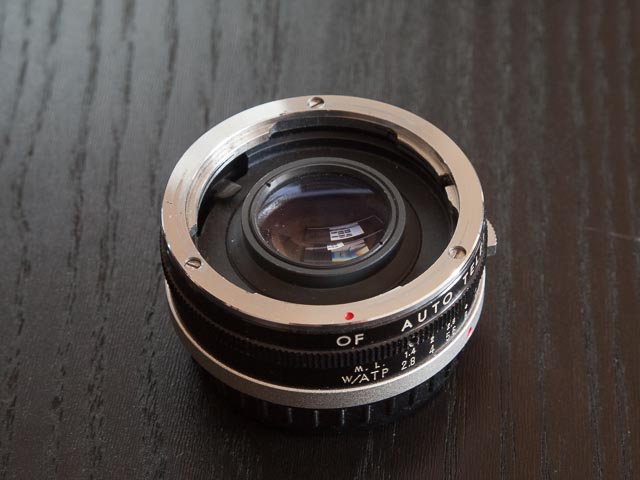
Using Olympus Pen F lenses on a digital camera

One of the great things about modern compact system cameras (CSCs… also known as mirrorless cameras) is the ease with which they can be adapted to use classic lenses from bygone eras. This is because the distance between the sensor and the front of the lens mount (the so called flange-back distance) is much less than most film cameras designed for 35mm film. This in turn means that the depth of the adapter doesn’t prevent the lens from focusing to infinity. The manufacturers of many CSCs often make adapters themselves (for example, Fujifilm make an adapter to fit Leica M mount lenses on their cameras). But because a basic adapter is so easy to make, a host of small far east companies make adapters for practically every other mount you can imagine. They then sell them on Amazon and eBay for very little money, generally in the £15-25 range.
Of course the Pen F mount is no exception. But because Olympus Pen F lenses are the only interchangeable lenses specifically designed for the 35mm half-frame format, they work particularly well when adapted to CSCs with APS-C sensors. The half-frame format (18x24mm) is only very slightly larger than the digital APS-C sensor format (generally around 15.5x23.5mm). This means that when you mount an Olympus Pen F lens on an APS-C digital camera you are using the lens pretty much within it’s intended scope. So a wide angle lens on an Olympus Pen F camera is still a wide angle lens on an APS-C camera. The crop factor for half frame film is 1.4x and for APS-C it is 1.5x

The crop factor for M4/3 cameras, such as those made by Olympus and Panasonic is 2x, so you are using Pen F lenses somewhat outside of their original scope, but the difference is still much smaller then when you mount 35mm full frame lenses on a M4/3 camera.
I find that on my Fujifilm X-E1 camera (35mm equiv. focal lengths in brackets) my 20mm f/3.5 (30mm), 25mm f/2.8 (37mm, not show in the above X-E1 photo), 38mm f/3.5 macro (59mm), 40mm f/1.4 (60mm), 60mm f/1.5 (90mm) and 100mm f/3.5 (150mm) make the most sense. Together these lenses cover a really useful range of focal lengths.
On my Olympus Digital Pen M4/3 cameras the wide angle lenses make less sense, as they just become rather slow standard lenses, but the 38mm f/3.5 macro (76mm), 40mm f/1.4 (80mm) and 60mm f/1.5 (120mm) make wonderful macro and fast short telephoto lenses.
The Pen F 38mm macro lens is a particular favourite. This tiny lens weighs just 230 grams including the mount adapter, and gives superb results on both APS-C and M4/3 cameras.
Using Olympus Pen F lenses on a full-frame digital camera
But despite having just gone on at some length about how well suited these lenses are to use on cameras with an APS-C sensor, I've always been curious about how well they would adapt to use on a full-frame camera. I recently decided to do a comprehensive survey of these lenses on my full-frame Sony A7II camera. The answer is surprisingly well! The 70mm f/2.0 lens in particular can be treated effectively as a full frame lens without any compromises at all. The 25mm f/4, 38mm f/2.8, 38mm f/2.8 (pancake version) G.Zuiko, 60mm f/1.5 and 100mm f/3.5 lenses can be uses on full-frame with little to no vignetting, but with significant smearing in the corners that some may never-the-less which to crop out. The 40mm f/1.4, 20mm f/3.5, 25mm f/2.8, 38mm f/3.5 macro, 150mm f/4 and 50-90mm f/3.5 lenses all have areas in the corners that are completely black, but they still benefit from use on full-frame as you can usually get away with less than a 20% crop (sometimes far less than 20%!), so using them on full-frame allows you to customise the crop on a case-by-case to use an area that is smaller than full-frame, but larger than APS-C.
You can find out more in the Olympus Pen F lenses on full-frame digital article.
